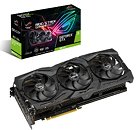Sunday, February 24th 2019

ASUS Unveils its GeForce GTX 1660 Ti Turing Graphics Cards
NVIDIA's Turing architecture offers a lot of cutting-edge functionality. Its highest-profile features-RT cores for real-time ray tracing and Tensor cores for Deep Learning Super Sampling (DLSS)-are forward-looking in that they will be increasingly more impactful as developers integrate their powerful functionality into more games. But beyond those two capabilities, the design is also optimized to help enthusiasts get more performance out of today's most popular titles, right out of the box.
The first Turing-based graphics cards were decidedly high-end, targeting price points and performance levels where ray tracing and DLSS would shine together. Now, it's time for Turing to strut its stuff in a more value-oriented context. With the NVIDIA GeForce GTX 1660 Ti, gamers gain access to the huge per-core performance lift of Turing, along with next-gen GDDR6 VRAM that offers much greater memory bandwidth than the previous generation.Meet the first Turing-based GeForce GTX
New GPU architectures continue to bring higher absolute performance, and they generally improve overall efficiency as well. Truly, it's a great time to be a PC gamer, regardless of your budget. Once upon a time, graphics cards capable of sustaining 60 FPS with quality settings cranked up were exclusive to high-end rigs. But now it's possible to get that kind of performance from mid-range models. Turing GPUs are manufactured on a 12nm FinFET process that packs more transistors into a smaller die than their Pascal predecessors. The new architecture can also execute integer and floating-point instructions at the same time over independent data paths, which wasn't possible previously without encountering a bottleneck. Furthermore, Turing unifies shared memory, texture caching, and memory load caching into a single unit, cranking the knob on available bandwidth. Together, NVIDIA says those enhancements drive an average performance improvement of 50% per core, which the NVIDIA GeForce GTX 1660 Ti series graphics cards wield to great effect.
The NVIDIA GeForce GTX 1660 Ti is complemented by a host of software-based features, too. Ansel gives this new card the power to capture picture-perfect screenshots in games with support for the technology. You're able to pause the action, move the camera around, apply filters, and save doctored-up images to HDR. ShadowPlay, another utility enabled by NVIDIA's GeForce Experience software, leverages hardware acceleration to record and save gameplay highlights without affecting performance. And, of course, G-Sync support provides smooth tear-free gaming when paired with a compatible display, an especially useful capability for a mid-range card tasked with balancing smooth animation and high-quality graphics.
The NVIDIA GeForce GTX 1660 Ti launch clearly gives gamers with older graphics cards a compelling reason to upgrade, and ASUS is offering four different versions of NVIDIA's first Turing-based GeForce GTX. After all, choice is a beautiful thing.
For the uncompromising, there's Strix
For gamers who "want it all," history has proven that the ROG Strix series delivers, so our 1660 Ti line-up would feel rather incomplete without it. The ROG Strix GTX 1660 Ti delivers high frame rates without breaking a sweat. It all starts with our MaxContact technology that improves contact between the GPU die and heat sink for improved thermal transfer. Three Axial-tech fans perched above the cooler feature a smaller hub that facilitates longer blades, along with a barrier ring to increase downward air pressure. More heat making its way into the sink and more air blowing through the cooler's fins allow NVIDIA's GPU to run at lower temperatures, enabling higher sustained GPU Boost clock rates. The result is better overall performance during long gaming sessions.
Our ROG Strix GTX 1660 Ti is further augmented with a reinforced frame to improve rigidity, minimizing the chance it'll flex if you tote your PC to a LAN party. Tuners will appreciate the card's Dual BIOS feature. Both modes utilize the same power target and clock rates, but one firmware always keeps the fans spinning for optimized cooling, while the other employs a more conservative fan curve that prioritizes silent operation. When the GPU temperature drops below 55°C with the quiet BIOS active, the fans are able to drop into 0dB mode and stop spinning entirely. Our GPU Tweak II software facilitates further customization and control.
RGB lighting on the Strix GTX 1660 Ti's fan shroud is also customizable through our Aura software. And if you'd rather run inconspicuously, a Stealth mode button on the card turns off the LEDs.
When the going gets TUF
While all ASUS products are built with durability in mind, many gamers seek out components deliberately subjected to more stringent testing, and the TUF Gaming GeForce GTX 1660 Ti is built on a foundation of unflagging reliability.
To maximize the card's longevity, we used fans with dual-ball bearings, doubling the expected lifespan compared to sleeve bearings. An IP5X rating helps to prevent dust from entering the fan housings and interfering with operation. While it's easy enough to wipe the blades down every once in a while, you'd have a much tougher time disassembling the fans for a thorough cleaning. IP5X dust resistance means you won't ever need to.
We use the same Auto-Extreme Technology in the manufacturing of our TUF Gaming GeForce GTX 1660 Ti as we do with the other 1660 Ti variants. This fully automated process solders all on-board components in a single pass, which reduces the thermal strain on sensitive electronics. It also eliminates the use of harsh cleaning chemicals and improves the long-term reliability of the finished product.
To ensure stability in a range of conditions, TUF-series cards are punished with a 144-hour validation program that puts them through an onslaught of tests to ensure they can withstand unforgiving environments. They're also tested for compatibility with other TUF Gaming Alliance products to ensure flawless interoperability with other components in the TUF family.
Welcoming a dynamic duo
The ASUS Dual GeForce GTX 1660 Ti sets its sights on cool, clean fun. It also features a pair of IP5X dust-resistant fans to ensure that dirt never makes its way into the housings, which can negatively affect performance over time. Those fans serve up plenty of cooling throughput, keeping NVIDIA's GPU running at maximum performance. You can stop worrying about the temperatures inside your PC and focus on racking up victories in your favorite battle royal instead.
Another feature the Dual shares with our TUF-series card is the stringent 144-hour validation program that ensures durability. For gamers still sporting monitors with DVI ports, the Dual has you covered with a native output. Using adapters is no fun, we get it.
Spreading your wings with Phoenix
The last stop on our 1660 Ti tour is the dual-slot Phoenix GeForce GTX 1660 Ti. The name conjures images of an immortal bird bursting from the ashes of reincarnation, wings spread wide. That's how you can expect to feel when you upgrade from an old GeForce GTX 700- or 900-series card.
The Phoenix GeForce GTX 1660 Ti includes Wing-blade fans with drooped tips that reduce drag and static pressure without taking up more space in the shroud. These fans also feature dual-ball bearings to improve durability.
A lot of Turing for your dollar
NVIDIA's Turing architecture incorporates a long list of improvements over the previous-generation without even dipping into RTX territory. Tweaks to the CUDA cores, cache hierarchy, and memory subsystem have a big impact on performance, and those are benefits that can be enjoyed today across a broad range of games. Our GeForce GTX 1660 Ti series offers something for every kind of gamer, especially those looking to upgrade to Turing without the high price tag.ASUS's ROG Strix, Dual, TUF Gaming, and Phoenix GeForce GTX 1660 Ti graphics cards launch on February 22.
The first Turing-based graphics cards were decidedly high-end, targeting price points and performance levels where ray tracing and DLSS would shine together. Now, it's time for Turing to strut its stuff in a more value-oriented context. With the NVIDIA GeForce GTX 1660 Ti, gamers gain access to the huge per-core performance lift of Turing, along with next-gen GDDR6 VRAM that offers much greater memory bandwidth than the previous generation.Meet the first Turing-based GeForce GTX
New GPU architectures continue to bring higher absolute performance, and they generally improve overall efficiency as well. Truly, it's a great time to be a PC gamer, regardless of your budget. Once upon a time, graphics cards capable of sustaining 60 FPS with quality settings cranked up were exclusive to high-end rigs. But now it's possible to get that kind of performance from mid-range models. Turing GPUs are manufactured on a 12nm FinFET process that packs more transistors into a smaller die than their Pascal predecessors. The new architecture can also execute integer and floating-point instructions at the same time over independent data paths, which wasn't possible previously without encountering a bottleneck. Furthermore, Turing unifies shared memory, texture caching, and memory load caching into a single unit, cranking the knob on available bandwidth. Together, NVIDIA says those enhancements drive an average performance improvement of 50% per core, which the NVIDIA GeForce GTX 1660 Ti series graphics cards wield to great effect.
The NVIDIA GeForce GTX 1660 Ti is complemented by a host of software-based features, too. Ansel gives this new card the power to capture picture-perfect screenshots in games with support for the technology. You're able to pause the action, move the camera around, apply filters, and save doctored-up images to HDR. ShadowPlay, another utility enabled by NVIDIA's GeForce Experience software, leverages hardware acceleration to record and save gameplay highlights without affecting performance. And, of course, G-Sync support provides smooth tear-free gaming when paired with a compatible display, an especially useful capability for a mid-range card tasked with balancing smooth animation and high-quality graphics.
The NVIDIA GeForce GTX 1660 Ti launch clearly gives gamers with older graphics cards a compelling reason to upgrade, and ASUS is offering four different versions of NVIDIA's first Turing-based GeForce GTX. After all, choice is a beautiful thing.
For the uncompromising, there's Strix
For gamers who "want it all," history has proven that the ROG Strix series delivers, so our 1660 Ti line-up would feel rather incomplete without it. The ROG Strix GTX 1660 Ti delivers high frame rates without breaking a sweat. It all starts with our MaxContact technology that improves contact between the GPU die and heat sink for improved thermal transfer. Three Axial-tech fans perched above the cooler feature a smaller hub that facilitates longer blades, along with a barrier ring to increase downward air pressure. More heat making its way into the sink and more air blowing through the cooler's fins allow NVIDIA's GPU to run at lower temperatures, enabling higher sustained GPU Boost clock rates. The result is better overall performance during long gaming sessions.
Our ROG Strix GTX 1660 Ti is further augmented with a reinforced frame to improve rigidity, minimizing the chance it'll flex if you tote your PC to a LAN party. Tuners will appreciate the card's Dual BIOS feature. Both modes utilize the same power target and clock rates, but one firmware always keeps the fans spinning for optimized cooling, while the other employs a more conservative fan curve that prioritizes silent operation. When the GPU temperature drops below 55°C with the quiet BIOS active, the fans are able to drop into 0dB mode and stop spinning entirely. Our GPU Tweak II software facilitates further customization and control.
RGB lighting on the Strix GTX 1660 Ti's fan shroud is also customizable through our Aura software. And if you'd rather run inconspicuously, a Stealth mode button on the card turns off the LEDs.
When the going gets TUF
While all ASUS products are built with durability in mind, many gamers seek out components deliberately subjected to more stringent testing, and the TUF Gaming GeForce GTX 1660 Ti is built on a foundation of unflagging reliability.
To maximize the card's longevity, we used fans with dual-ball bearings, doubling the expected lifespan compared to sleeve bearings. An IP5X rating helps to prevent dust from entering the fan housings and interfering with operation. While it's easy enough to wipe the blades down every once in a while, you'd have a much tougher time disassembling the fans for a thorough cleaning. IP5X dust resistance means you won't ever need to.
We use the same Auto-Extreme Technology in the manufacturing of our TUF Gaming GeForce GTX 1660 Ti as we do with the other 1660 Ti variants. This fully automated process solders all on-board components in a single pass, which reduces the thermal strain on sensitive electronics. It also eliminates the use of harsh cleaning chemicals and improves the long-term reliability of the finished product.
To ensure stability in a range of conditions, TUF-series cards are punished with a 144-hour validation program that puts them through an onslaught of tests to ensure they can withstand unforgiving environments. They're also tested for compatibility with other TUF Gaming Alliance products to ensure flawless interoperability with other components in the TUF family.
Welcoming a dynamic duo
The ASUS Dual GeForce GTX 1660 Ti sets its sights on cool, clean fun. It also features a pair of IP5X dust-resistant fans to ensure that dirt never makes its way into the housings, which can negatively affect performance over time. Those fans serve up plenty of cooling throughput, keeping NVIDIA's GPU running at maximum performance. You can stop worrying about the temperatures inside your PC and focus on racking up victories in your favorite battle royal instead.
Another feature the Dual shares with our TUF-series card is the stringent 144-hour validation program that ensures durability. For gamers still sporting monitors with DVI ports, the Dual has you covered with a native output. Using adapters is no fun, we get it.
Spreading your wings with Phoenix
The last stop on our 1660 Ti tour is the dual-slot Phoenix GeForce GTX 1660 Ti. The name conjures images of an immortal bird bursting from the ashes of reincarnation, wings spread wide. That's how you can expect to feel when you upgrade from an old GeForce GTX 700- or 900-series card.
The Phoenix GeForce GTX 1660 Ti includes Wing-blade fans with drooped tips that reduce drag and static pressure without taking up more space in the shroud. These fans also feature dual-ball bearings to improve durability.
A lot of Turing for your dollar
NVIDIA's Turing architecture incorporates a long list of improvements over the previous-generation without even dipping into RTX territory. Tweaks to the CUDA cores, cache hierarchy, and memory subsystem have a big impact on performance, and those are benefits that can be enjoyed today across a broad range of games. Our GeForce GTX 1660 Ti series offers something for every kind of gamer, especially those looking to upgrade to Turing without the high price tag.ASUS's ROG Strix, Dual, TUF Gaming, and Phoenix GeForce GTX 1660 Ti graphics cards launch on February 22.





5 Comments on ASUS Unveils its GeForce GTX 1660 Ti Turing Graphics Cards
It looks like they took the card with a single fan and just put a shroud with two fans on it, but left the small heatsink.
ASUS engineers be like "more fans = more cooling". Not with a tiny heatsink in between the two fans. Wouldn't be surprised if that card has worse temps than the single fan one.
That inferior heatsink doesn't make it cheaper, it's currently €20 above the lowest priced 1660 Ti.
geizhals.eu/?cat=gra16_512&xf=9810_9+4608+-+GTX+1660+Ti
I thought Inno3Ds Twin X2 looked a bit iffy, but compared to the TUF and DUAL versions its in a different league...